Results from the June 2012 Scottish Agricultural Census
Final results from the annual agricultural census. Land, livestock and labour items.
This document is part of a collection
3. Commentary
3.1 Agricultural Area (Table 1)
Chart 1: Agricultural land use, June 2012
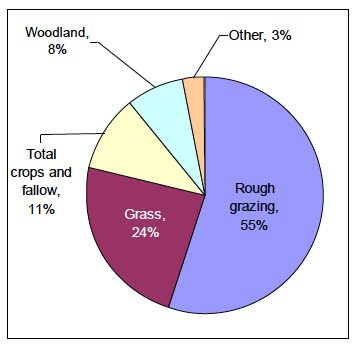
The total area on agricultural holdings at June 2012 was 5.6 million hectares, with the majority of this area comprised of rough grazing (55 per cent). Almost a quarter (24 per cent) was taken up by grass, with 11 per cent used for crops or left fallow. The remainder consisted of woodland (eight per cent) and 'other land' (three per cent) comprised of roads, yards, buildings, scree, ponds and other such non-cultivated land.
The total area on agricultural holdings equated to 73 per cent of Scotland's total land area.
Chart 2: Agricultural land use trends, 2002 to 2012
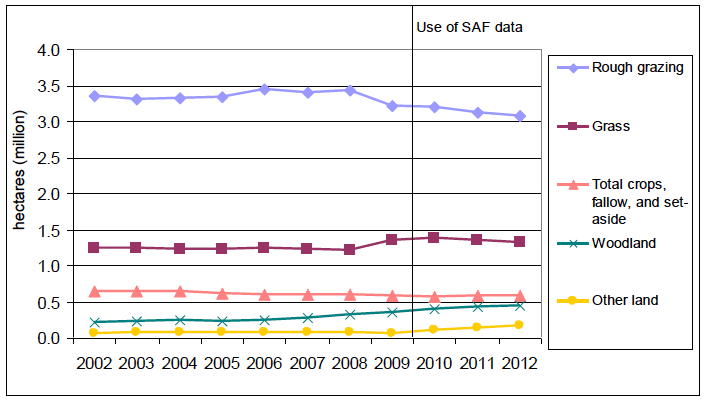
Over the past ten years, the total area on agricultural holdings varied between 5.51 and 5.65 million hectares. This variation is more likely to reflect changes to the coverage of agricultural holdings and their areas as recorded on the June Census register, rather than genuine changes in total agricultural land.
From 2009, administrative data on land use has been utilised for holdings which claim Single Farm Payments and other schemes through the Single Application Form (SAF). This development has improved the overall coverage of land use statistics within the June Agricultural Census, as well as significantly reducing the need for survey data collection. It did however introduce a step change into the land use series between 2008 and 2009, mostly affecting rough grazing and grassland, where a certain amount of substitution occurred between these two categories, with rough grazing figures decreasing by 216,100 hectares and grass land increasing by 142,300 hectares. Most other land use series do not appear to have been adversely affected by the switch to SAF data and results before and after 2009 can be reliably compared.
For the fourth year running there was a reduction in the area of rough grazing, with a drop of 38,800 hectares (1.2 per cent) observed this year. Conversely the 'other land' category rose for the third year running, and it may be that the reduction in rough grazing can be partly explained by more precise recording of usable and unusable areas within individual fields reported on the Single Farm Payments system.
Overall, the area of grass fell only slightly (32,400 hectares or 2.4 per cent), with a 49,700 hectare (5.3 per cent) fall in the area of permanent grass partly offset by a 17,400 hectare (4.2 per cent) rise in the area of temporary grass. These changes may be partly explained by rotation, particularly farmers re-sowing grass on land previously occupied by permanent grass.
In addition, the increase of woodland on agricultural land (up 19,300 hectares or 4.5 per cent) to 445,400 hectares in 2012) may also have contributed to the decrease in rough grazing. It is notable that the area of woodland reported on agricultural holdings increased by 235,500 hectares (112 per cent) over the past ten years. Though this may be partly due to increased coverage of this type of land by the June census register, consistent increases in woodland over the last decade suggest genuine increase may also be driving the trend.
3.2 Crops, fallow and set aside land (Table 1)
In 2012, there were 588,900 hectares of crops and fallow land, with cereals accounting for the majority (78 per cent or 457,700 hectares). Oilseeds made up 6.2 per cent and fallow land 2.6 per cent. The remaining 13 per cent was comprised mainly of potatoes, stock feeding crops and fruit and vegetables.
Chart 3: Trends in Crops, fallow and set-aside land 2002 to 2012
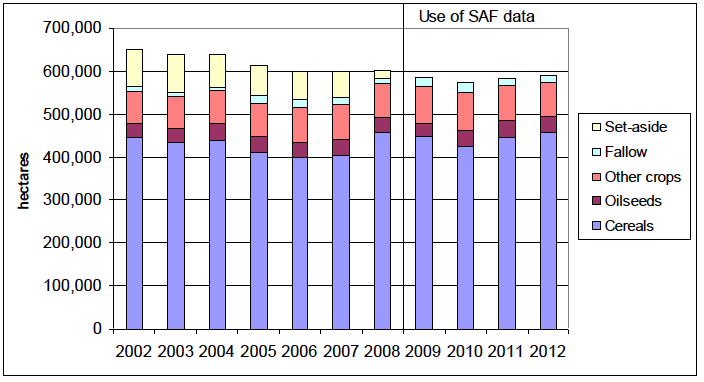
Chart 3 displays trends in these categories over the past ten years, including set-aside land up to 2008. The area of set-aside land was driven by compulsory EC set-aside rates (ten per cent between 2000 and 2003; five per cent between 2004 and 2007, and zero in 2008), as well as by the use of voluntary set-aside, until set-aside was abolished from 2009 in the Common Agricultural Policy (CAP) Health Check. Over this period set-aside land peaked at just over 90,000 hectares in 2003.
Set-aside was originally introduced to limit the production of cereals in the EU and was applied on a voluntary basis from 1988/89, becoming compulsory from 1993. In 2005, the Single Farm Payment was introduced, which decoupled subsidy payments from crop areas, which was then followed by a decrease in the total crop, fallow and set-aside land of 38,500 hectares (six per cent) between 2004 and 2006.
Cereal areas were at their lowest in 2006 and 2007, but increased by 52,900 hectares (13 per cent) in 2008 in response to tight EU and world supply, high market prices following the 2007 harvest and a reduction in compulsory set-aside rates to zero. There were decreases in cereal areas in the years 2009 and 2010 as market prices dropped and the supply situation eased.
Cereal prices have since risen, with farms choosing to plant cereal crops at the expense of less profitable crops such as oilseed rape (down 4.7 per cent) and linseed. In June 2012, the total area of cereal crops was 457,700 hectares, up 10,600 hectares (up 2.4 per cent).
3.3 Cereals (Table 1)
Spring barley was the dominant cereal crop accounting for 289,200 hectares (63 per cent) of the total cereal area in June 2012, with winter barley adding a further 42,800 hectares (9.4 per cent of the total cereal crop area). Wheat, a predominantly winter crop, accounted for 100,600 hectares (22 per cent of the total cereal crop area), while oats contributed 23,700 hectares (5.2 per cent of the total cereal crop area).
Chart 4: Cereal Trends, 2002 to 2012
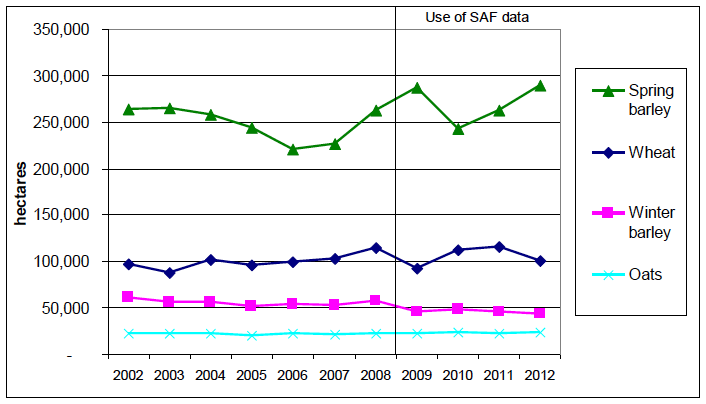
A notable factor in trends in cereal crops was the effect of weather conditions over the last year, particularly the wet autumn of 2011, which resulted in some farmers having difficulty sowing winter crops. As a consequence, areas of winter barley (down 5.9 per cent), winter oats (down 22 per cent) and wheat (down 13 per cent) fell, while in contrast, the more profitable spring barley (up ten per cent) and spring oats (up 23 per cent) were sown across greater areas. Similar conditions were experienced in 2008, resulting in corresponding falls and increases observed in June 2009 in winter and spring cereal crop areas respectively.
The trends between June 2011 and June 2012 demonstrate:
- An increase in total barley of 23,600 hectares (7.7 per cent) to 332,000 hectares.
- An decrease in wheat of 14,800 hectares (13 per cent) to 100,600 hectares.
- A increase in oats of 2,000 hectares (9 per cent) to 23,700 hectares.
Further Information
Statistics on crop yield and production for cereals and oilseed rape are available from Scottish Harvest Publications[2]. First estimates of the cereal and oilseed rape harvests 2012 have been pre-announced for publication on 10th October 2012.
3.4 Oilseed Rape (Table 1)
Over the past ten years, the total area of oilseed rape has fluctuated between 29,000 and 39,000 hectares. Figures for June 2012 show a drop of 1,800 hectares on the previous year to 36,600 hectares. The area of land sown with spring oilseed rape has dropped for the third consecutive year, this time by 27 per cent, from 1,470 hectares to 1,070 hectares.
Chart 5: Oilseed Rape (OSR) Trends, 2002 to 2012
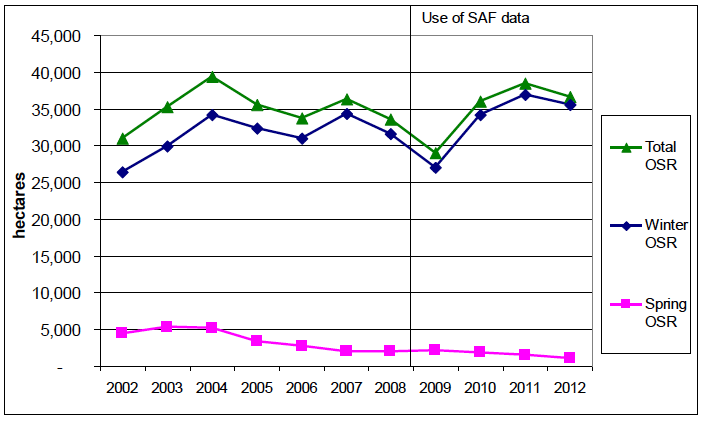
3.5 Potatoes (Table 1)
The area of potatoes grown fell for the third consecutive year, driven largely by a fall in ware potatoes. The drop of 1,500 hectares (4.9 per cent) brought the area of potatoes grown to the lowest figure since 2007.
Chart 6: Potato Trends, 2002 to 2012
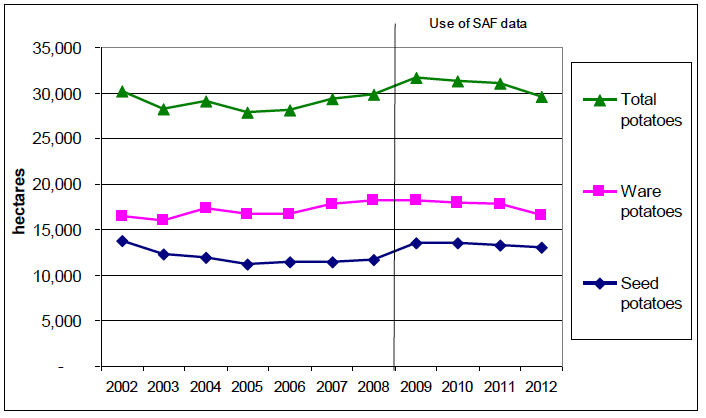
3.6 Peas & Beans for Combining (Table 1)
The peas and beans described here are usually harvested by combine harvester (hence the name) and used as a source of protein in animal feed. Chart 7 demonstrates that there has been considerable fluctuation in the area of beans, from a low of 1,900 hectares in 2003 to 5,300 in 2010. Though a sharp fall in 2011 was followed by a modest rise of 50 hectares (1.4 per cent) in 2012, the current area is about twice that of a decade ago. Peas for combining, by contrast have displayed a strong downward trend in the area grown over the last three years, with the 2012 figure of 682 hectares representing the lowest figure in the past ten years with a fall of 516 hectares or 43 per cent. There is a suggestion that farmers are substituting this crop, particularly peas, for beans normally intended for human consumption (and reported as such) which are then being processed into animal feed protein.
Chart 7: Trends in Peas & Beans for Combining, 2002 to 2012
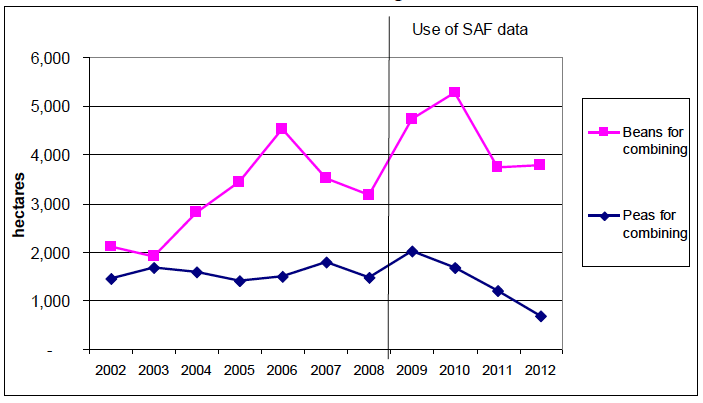
3.7 Crops for Stockfeeding (Table 1)
The total area of stockfeeding crops declined between 2006 and 2008, which coincided with a greater rate of decline in cattle and sheep numbers. The area remained fairly stable between 2008 and 2010 but declined in 2011 by 3,048 hectares (13.2 per cent) to 19,989 hectares, possibly due to farmers responding to higher prices in cereals and switching crops. In June 2012, the area fell only slightly (by 170 hectares or 0.8 per cent) though there were some notable changes within this. Falls in the area of turnips and swedes, fodder beet, lupins and other stockfeeding crops were largely offset by increases in kale and cabbage, and rape. The increase in the area of kale and cabbage was the first since 2006, while the area of rape rose for the first time since 2005.
Chart 8: Trends in Stockfeeding crops, 2002 to 2012
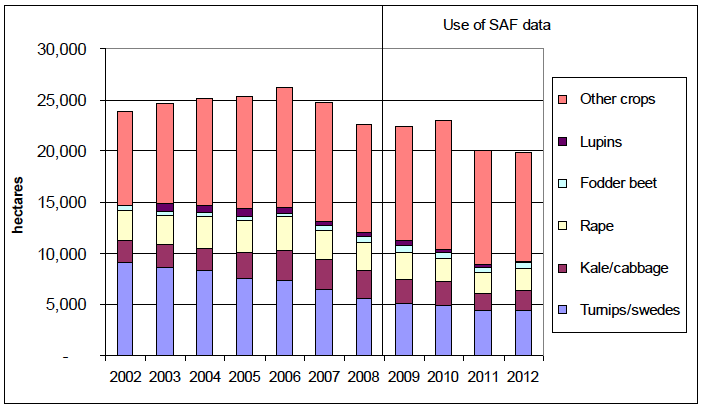
3.8 Vegetables for Human Consumption (Table 2)
Chart 9: Vegetables for Human Consumption, 2012
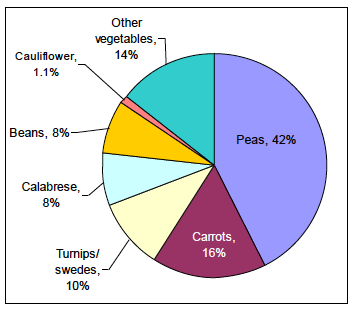
The total area of vegetables grown in the open for human consumption at June 2012 was 15,400 hectares. As has been the case over the last ten years, peas were the dominant vegetable accounting for 42 per cent of the total vegetable area, followed by carrots (16 per cent), turnips/swedes (10 per cent), beans and calabrese (a crop similar to broccoli) (both eight per cent), with all other vegetable crops, including cauliflower, contributing 15 per cent.
Trends show that total vegetable areas increased by 2,157 hectares (21.3 per cent) between 2002 and 2008, mostly due to increases in peas and carrots. There was a further increase of 3,745 hectares (30.5 per cent) between 2008 and 2009, but this may represent a step change in the data series following the switch to using SAF data for those holdings claiming Single Farm Payment.
Following a drop in 2011, a small increase of 184 hectares (1.2 per cent) in the total vegetable area was observed in June 2012. This increase was largely driven by a 20 per cent rise in the area of peas (up 280 hectares or 4.4 per cent) and beans (from 1,000 to 1,200 hectares), offsetting falls in calabrese, cauliflower and other vegetables. As mentioned in Section 3.6, there is a suggestion that the rise in beans may be partly explained by farmers processing them for use in animal feed.
Chart 10: Vegetables for Human Consumption, Trends 2002 to 2012
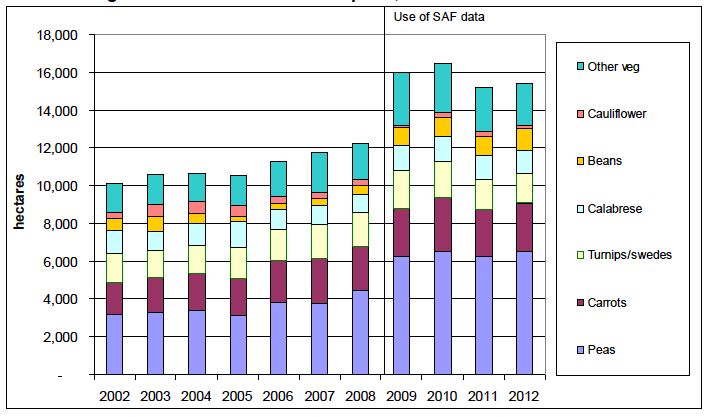
3.9 Fruit (Table 2)
In 2012, the Single Application Form (SAF) was amended to collect more detailed information on soft fruit, particularly with regard to identifying whether crops were grown in open fields, glasshouses or walk-in plastic structures. This has resulted in a large shift between areas counted as open field and glasshouse or walk-in plastic structures.
The area of strawberries and raspberries in open fields was 186 and 205 hectares respectively, less than a third of the area reported in 2011. Conversely, the area of these crops grown under glass and walk-in plastic structures has tripled when compared to last years figure.
This alteration to the SAF follows an amendment to the census form in 2011 which allowed areas of strawberries and raspberries grown under glass to be recorded. We consider that these changes have allowed us to improve the accuracy of our estimates and that the changes in strawberry and raspberry areas are largely a result of this as opposed to genuine changes in the area of crops grown. Please see section 4.10 for more information on the methodology employed in response to these changes.
Chart 11 presents combined areas of soft fruit in both open field and in glasshouses in walk-in plastic structures. Given the changes described above, these trends should be treated with some caution. Between 2011 and 2012 there was a drop of 116 hectares (11.6 per cent in the area of strawberries grown and a drop of 123 hectares (24.0 per cent) in the area of raspberries grown. The area of blackcurrants and mixed fruit remained relatively stable over this period.
Chart 11: Soft Fruit trends (both open field and plastic and glasshouse crops) 2002 to 2012
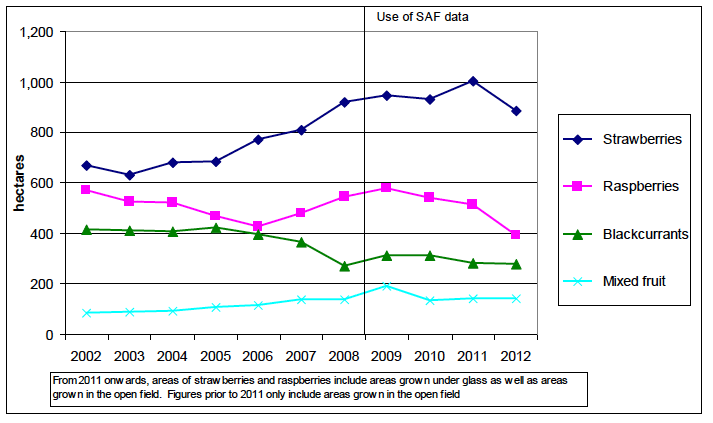
3.10 Bulbs, flowers & hardy nursery stock (Table 2)
The area of land used to grow bulbs, flowers and nursery stock rose by 137 hectares (13.2 per cent) in the last year to 1,174 hectares. This represents the biggest annual increase in land area for these crops in a previously steady figure during the last ten years.
3.11 Livestock Trends Summary (Tables 3 to 6)
Chart 12 presents livestock trends as indices. This demonstrates the relative change of each livestock category from the baseline year of 2002 and can be used to compare trends across livestock with quite different population totals. Decreases in livestock are evident for all categories across the ten year period. The largest decreases have occurred among pigs (30.9 per cent) and sheep (16.5 per cent). Smaller decreases are evident among cattle (7.6 per cent) and poultry (5.5 per cent).
Chart 12: Livestock indices, ten-year trends relative to 2002
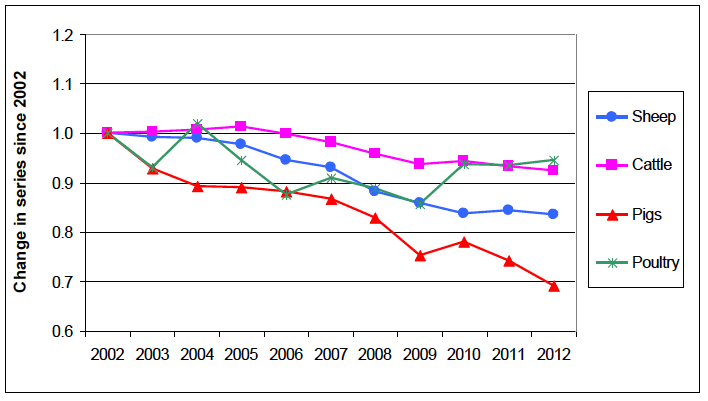
The chart illustrates how the cattle population recovered in the years following the outbreak of foot and mouth in 2000, with rises in numbers in the years up to 2005. This was accompanied by a corresponding decrease in sheep numbers, which has continued in all but one of the last ten years.
In 2005 the Single Farm Payment (SFP) scheme was introduced, which decoupled subsidy payments from most sheep and cattle production, with the exception of the Scottish Beef Calf Scheme. With the introduction of SFP the decline in sheep numbers accelerated, with a decrease of 14 per cent between 2005 and 2010, although the population has stabilised in the last two years, including a small increase (0.7 per cent) in 2011 due to increased lamb numbers. Cattle numbers have also been in decline, down by 8.8 per cent between 2005 and 2012, albeit increasing slightly in 2010.
The bulk of the decline in pig numbers over the last ten years occurred between 2002 and 2009, with a drop of 24.7 per cent observed over this period. A slight rise in 2010 owing to strong pig prices and an increase in the breeding herd was followed by an 11.5 per cent fall in total pig numbers over the last two years. Since 2002, the trend in poultry numbers has fluctuated with a decrease of 5.5 per cent up to 2012. There is however some variability in the annual poultry data, which can be affected by operational factors.
3.12 Cattle (Table 3)
Chart 13: Cattle population, June 2012
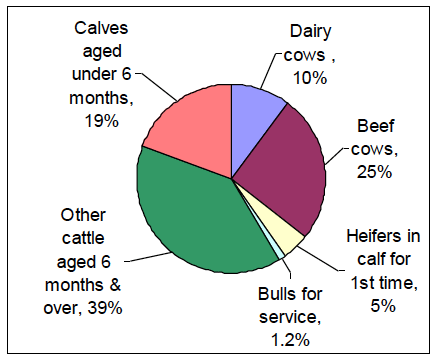
In June 2012, the cattle population was 1.79 million. The proportion of total cattle comprising beef cows (25 per cent) was two and a half times greater than the proportion of dairy cows (10 per cent) and a further five per cent of cattle were heifers in calf for the first time. Only one per cent of cattle were bulls for service. 19 per cent of cattle were calves aged under six months and 39 per cent were other cattle aged over six months, which may also include some older calves. The distribution of cattle amongst the categories displayed in Chart 13 is virtually unchanged from last year.
Chart 14 displays the relative trends of cows in the dairy and beef herds over the past ten years. Note that each data series has a different axis, with dairy cow numbers shown on the left axis and beef cow numbers on the right axis. Focusing on cows in the herd provides a good indication of overall trends in the dairy and beef sectors.
Chart 14: Dairy & Beef Herd Trends, 2002 to 2012
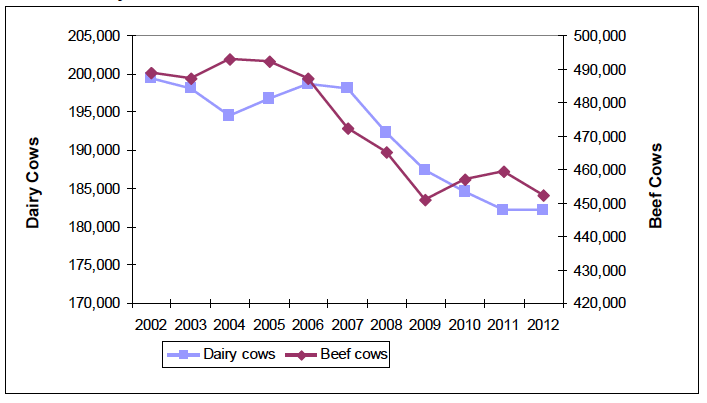
Overall trends in cattle were described in Section 3.11, with the total number falling 147,000 (7.6 per cent) from 1.93 million in 2002 to 1.79 million in 2012. Beef and dairy cows have followed similar trends over the last ten years, with dairy cows decreasing 17,200 (7.5 per cent) to 182,200 and beef cows decreasing by 36,500 (8.6 per cent) to 452,300.
It is noticeable that beef cows started to decline soon after the introduction of Single Farm Payments in 2005, decreasing by 41,502 (8.4 per cent) up till 2009. Dairy cows increased between 2005 and 2006 before declining by 16,400 (8.3 per cent) between 2006 and 2012, although the drop over the last year has been slight. Prior to 2005 there were no coupled subsidy payments for dairy cows, which may explain why they were not immediately affected by the introduction of Single Farm Payments in 2005. There has also been uncertainty in milk prices in this period which may have contributed to numbers declining. In 2012 beef cows decreased for the first time in three years, down 7,000 (1.4 per cent) on 2011 to 452,300.
The latest annual trends between 2011 and 2012 show:
- A decrease in total cattle of 15,500 (0.9 per cent) to 1.79 million.
- Negligible change in the dairy cows at 182,184.
- A decrease in the beef cows of 6,900 (1.5 per cent ) to 452,400.
3.13 Sheep (Table 4)
Chart 15: Sheep population, June 2012
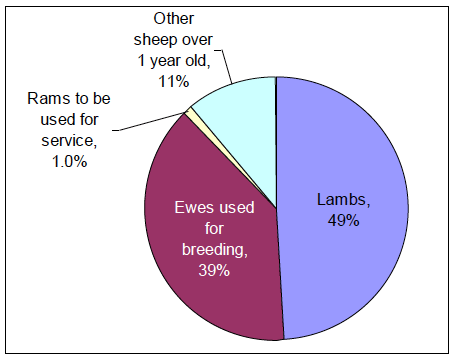
In June 2012 the sheep population was 6.74 million. Ewes used for breeding in the previous season accounted for 39 per cent of the total, with rams to be used for service just one per cent. Lambs made up the largest proportion with 49 per cent and other sheep over one year old accounted for 11 per cent. The distribution of sheep amongst the categories displayed in Chart 15 is virtually unchanged from last year.
Chart 16: Ewes used for breeding and lambs, trends 2002 to 2012
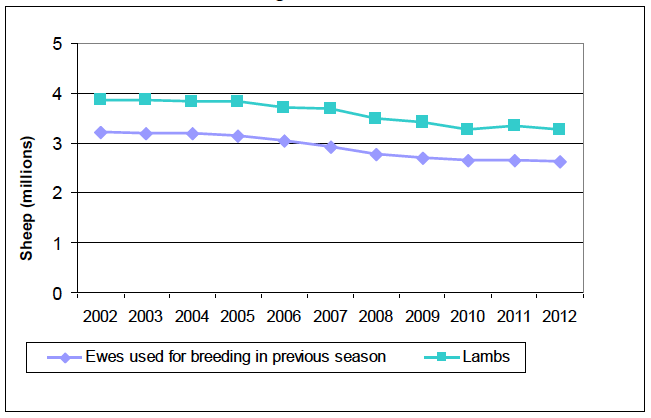
Overall trends in the sheep population were described in section 3.11, with the total decreasing by 1.33 million (16.5 per cent) from 8.06 million in 2002 to 6.74 million in 2012.
Chart 16 displays trends for breeding ewes and lambs, which in June 2012 made up 87.5 per cent of the total sheep population. Over the past ten years there has been a decline of 600,000 ewes for breeding (18.6 per cent) from 3.22 million in 2002 to 2.62 million in 2012. Lambs have declined at a slightly lower rate, from 3.85 to 3.27 million (a drop of 15.1 per cent).
In the first few years of the ten year period, between 2002 and 2005, the rate of decline in the number of sheep was slow (average decline of 0.7 per cent per annum) as the population adjusted to large losses from the foot and mouth outbreak experienced in 2000. After the introduction of Single Farm Payments in 2005, sheep numbers declined more rapidly with a decrease of 1.13 million sheep between 2005 and 2010 (annual average decline of 3.0 per cent).
Following an increase in the number of sheep in 2011, driven by an increase in the number of lambs, the number if sheep fell by 65,200 (one per cent) up to June 2012. This was partly attributable to a fall of 54,300 (1.6 per cent) in the number of lambs and, owing to strong prices at slaughter for sheep, to a fall of 18,000 in the number of ewes used for breeding.
The latest annual trends between 2011 and 2012 show:
- An decrease in total sheep of 65,200 (1.0 per cent) to 6.74 million.
- A decrease in ewes used for breeding of 18,000 (0.7 per cent) to 2.62 million.
- An decrease in lambs of 54,300 (1.6 per cent) to 3.27 million.
- An increase in other sheep aged one year and over of 7,800 (1.0 per cent) to 0.75 million.
3.14 Pigs (Table 5)
Chart 17: Pig population, June 2012
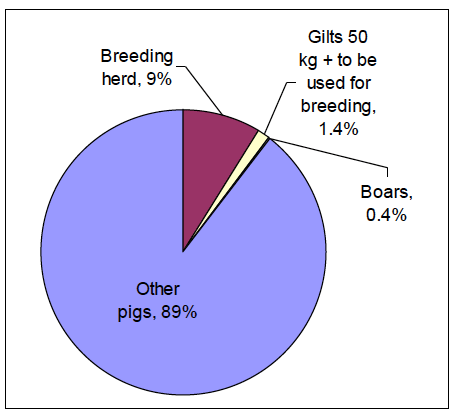
In June 2012 the pig population was 363,400. The breeding herd accounted for nine per cent of the total, with a further 1.4 per cent being gilts (over 50 kg) to be used for future breeding. Boars made up only 0.4 per cent of the population. Barren sows accounted for just 0.3 per cent while the vast majority (89 per cent) were other pigs most of which would be used for meat production.
Chart 18 shows the relative trends over the past ten years of the breeding herd and other pigs (mostly used for meat production). Note that each data series has a different axis, with breeding herd numbers shown on the left axis and other pig numbers on the right axis.
Overall trends in the pig population were described in Section 3.11, with the total decreasing by 162,800 (30.9 per cent) from 526,300 in 2002 to 363,400 in 2012. Over the same period, the breeding herd decreased by 23,700 (42.7 per cent) to 31,900 whilst other pigs for fattening decreased by 138,500 (29.9 per cent) to 324,000.
Chart 18: Breeding and Other Pigs, Trends 2002 to 2012
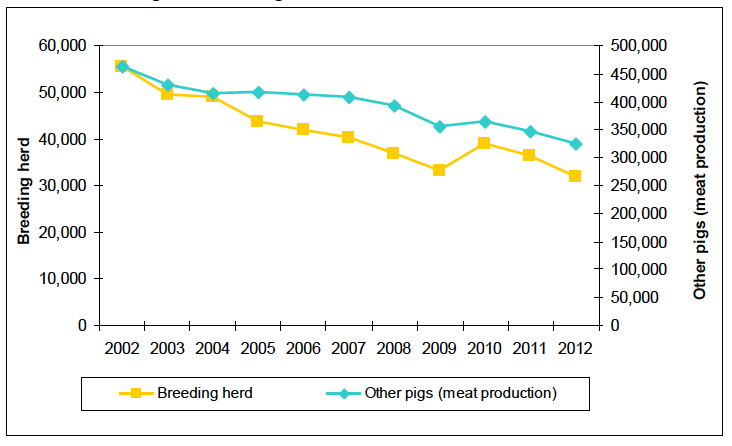
Over the last twelve months total pig numbers have fallen by 26,600 (6.8 per cent) to 363,400. Input costs for fuel and feed have risen over the last year and the drop in numbers may be attributable to farmers downsizing in advance of herds being restocked.
The latest annual trends between 2011 and 2012 show:
- A decrease in total pigs of 26,600 (6.8 per cent) to 363,400.
- A decrease in the breeding herd of 4,500 (12.3 per cent) to 31,900.
- A decrease in other pigs (mostly for meat production) of 22,200 (6.4 per cent) to 324,000.
3.15 Poultry (Table 6)
Chart 19: Poultry population, June 2012
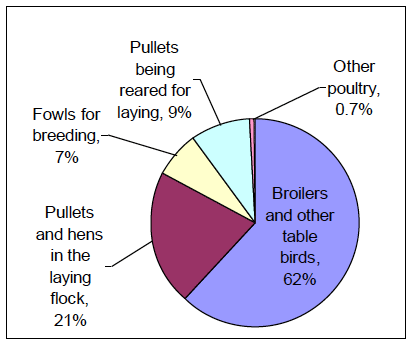
In June 2012 the total poultry population was 14.69 million. The majority were broilers and other table birds (62 per cent), followed by pullets and hens in the laying flock (21 per cent). Fowls for breeding accounted for seven per cent, whilst pullets being reared for laying made up nine per cent. Other poultry made up one per cent of the total.
Overall trends in the poultry population were described in Section 3.11, with the total decreasing by 850,100 (5.5 per cent) from 15.54 million in 2002 to 14.69 million in 2012.
Chart 20 shows differing trends over the same period for poultry used for meat and egg production. There was a decrease in broilers and other table birds of 1.59 million (14.9 per cent) to 9.07 million, whilst the number of fowls for producing eggs increased by 888,500 (24.9 per cent) to 4.46 million.
Chart 20: Trends in Broiler & Table Birds, and Fowls for producing eggs, 2002 to 2012
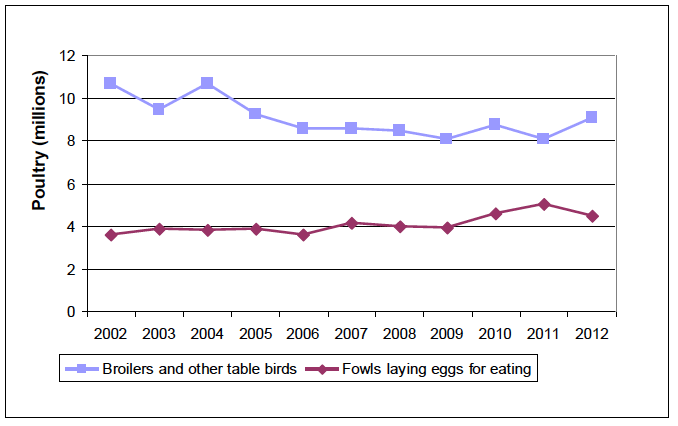
The EU Directive 1999/74/EC on laying hens stated that cage systems must have at least 750cm2 of cage area per hen (known as enriched cages). They must also provide a nest, perching space of 15cm per hen, litter to allow pecking and scratching and unrestricted access to a feed trough measuring at least 12cm per hen in the cage. This directive came into force in January 2012 and is likely to be the main factor behind the drop of 573,200 (11.4 per cent) in the number of fowls for producing eggs over the last year.
The latest annual trends between 2011 and 2012 show:
- An increase in total poultry of 167,600 (1.2 per cent) to 14.69 million
- A decrease in fowls laying eggs for eating of 573,200 (11.4 per cent) to 4.46 million.
- An increase in broiler and other table birds of 996,400 (12.3 per cent) to 9.07 million.
3.16 Other livestock (Table 7)
The number of "horses not for agricultural use" has increased over the past ten years by 12,000 (49.4 per cent) to 36,400. There were only a small number of horses used for agriculture, totalling 862 in 2011. Since 2002, farmed deer have decreased by 1,600 (20.1 per cent) to 6,100 and goats have declined sharply by 3,000 (44.1 per cent) to 3,800.
Chart 21: Other Livestock Trends, 2002 to 2012
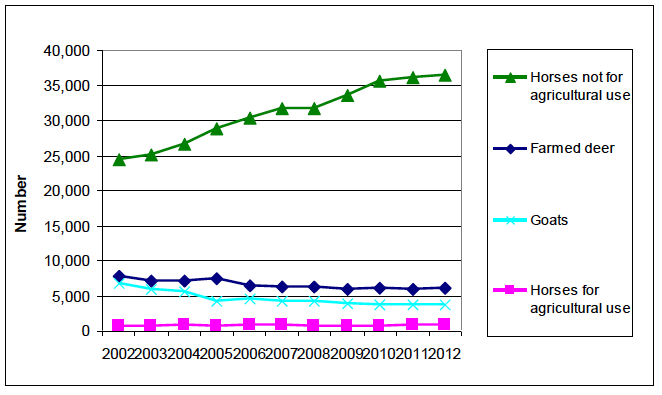
3.17 Agricultural Labour (Table 8)
Chart 22: Agricultural Labour, June 2012
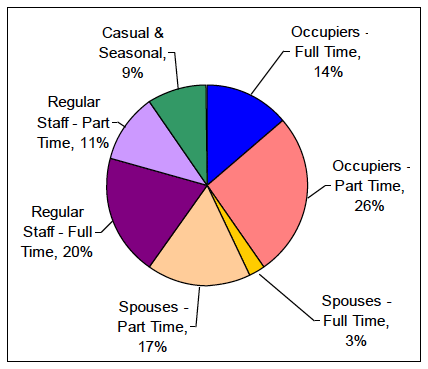
On the 1st June 2012, there were 68,400 people working on agricultural holdings. Working occupiers made up 40 per cent of the total workers (split between 14 per cent full-time and 26 per cent part-time). A further 19.5 per cent of the total workers were occupiers' spouses (with the majority of these working part-time). Regular staff accounted for 30.5 per cent of total workers (of which more were working full-time than part-time). A further breakdown of the various categories included within regular staff can be found in Chart 28. Casual and seasonal workers represented 9.5 per cent of the total.
Between 2011 and 2012, the number of people working in agriculture increased by 631 (0.9 per cent).
Notable decreases were seen in the numbers for:
- Full time working occupiers, which decreased by 139 (1.4 per cent) to 9,600.
- Casual and seasonal staff, which decreased by 453 (6.5 per cent) to 6,500 driven largely by a fall in female casual and seasonal staff.
Notable increases were seen for:
- Part time working occupiers, which increased by 213 (1.2 per cent) to 18,000, driving the total number of working occupiers (full and part time) to 27,600.
- Working spouses, up 333 (2.6 per cent) to 11,500.
- Regular part time staff, up 658 (9.6 per cent) to 7,500.
It should be noted that some of the annual changes in labour may have been affected by changes in the census form. Inclusion of EC Farm Structure Survey (FSS) questions on the June 2010 census (and the associated redesign of the survey form) led to some labour sections either not being reported correctly or being missed out by survey respondents. In 2011 the census form reverted back to its usual design and, it appears, has resulted in a spike or drop for some labour categories in 2010, particularly evident in numbers for occupiers and regular male staff.
Also, there was an additional change to the 2011 census form, adding in a category for non working occupiers and spouses. "Working occupier" and "working spouse" totals for 2011 do not include the non working categories. It may be possible in the past that non working occupiers and spouses were recorded under the "Less than half time" categories and therefore included in the total working occupier and spouse totals. These non working occupier and spouse categories have been excluded from the 2012 form though numbers for these categories have been imputed. See Section 4.11 for more information.
Looking at longer-term trends, there was a decrease of 3,800 (5.5 per cent) in the number of people working on agricultural holdings from 68,300 in 2002 to 64,500 in 2008. Numbers have risen consistently since then, by 3,900 (6.1 per cent) from 2008 to 2012's total of 68,400. These totals need to be treated with some caution as they include differing trends for full-time and part-time occupiers, spouses and regular employees.
Chart 23 shows similar trends for working occupiers and regular employees, with a general decline between 2002 and 2008 followed by increases up to 2010. Compared with 2002, the total number of working occupiers is now 662 (2.3 per cent) lower and the number of regular employees is 1,072 (4.9 per cent) lower. The total number of working spouses increased gradually up to 2005, but has followed a downward trend since. Compared to 2002, the number of working spouses is now 675 (4.8 per cent) lower. The number of casual and seasonal staff employed on 1st June rose by 2,500 (64.5 per cent) with much of this rise coming in the latter half of the past decade.
Chart 23: Agricultural Labour Trends, 2002 to 2012
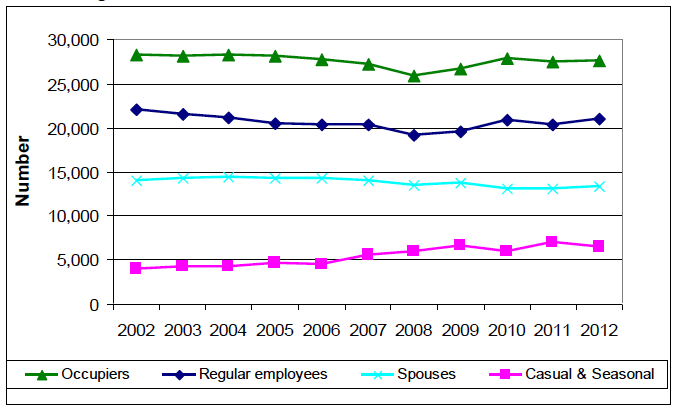
Chart 24 provides a further breakdown of trends in working occupiers. It shows that between 2002 and 2008 there was a decrease in full-time occupiers of 1,900 (16.6 per cent) to 9,491. Numbers have since been broadly level, standing at 9,600 in 2012. The number of part-time occupiers working "half-time or more" has been fairly constant since 2002, whereas there has been an increase of the number of occupiers working "less than half-time", particularly since 2008, since when numbers have increased by 1,300 (10.2 per cent) to 14,000. The peak of 14,222 "less than half-time occupiers" in 2010 may be an effect of adding the Farm Structure Survey questions and altering the design of the form for that year.
Chart 25 shows that in 2012, spouses were more likely to work less than half-time on agricultural holdings in comparison to other working patterns, with this category representing 9,300 (69.8 per cent) of the total number of working spouses.
Chart 24: Occupiers, Trends 2002 to 2012
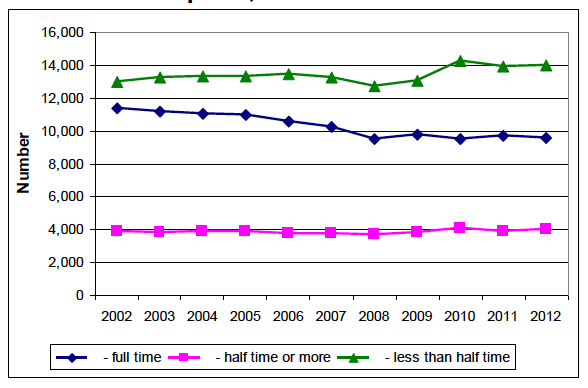
Chart 25: Spouses, Trends 2002 to 2012
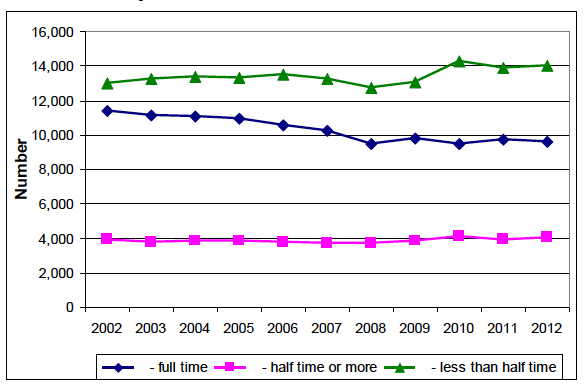
Charts 26 and 27 provide a further breakdown of trends in regular employed staff. They show that the overall trends are almost entirely driven by trends in full time male staff, which decreased by 2,500 (17.9 per cent) between 2002 and 2008, before increasing by 600 (5.4 per cent) between 2008 and 2012.
Chart 26: Regular Male Staff, Trends 2002 to 2012
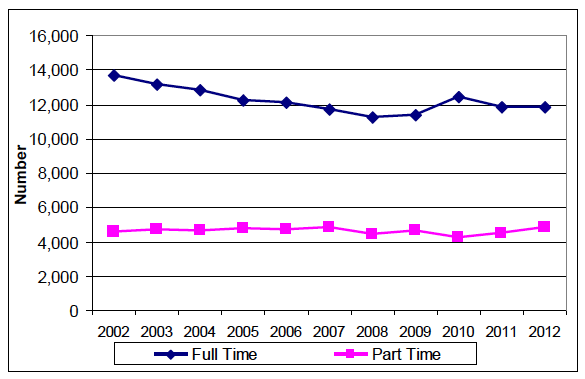
Chart 27: Regular Female Staff, Trends 2002 to 2012
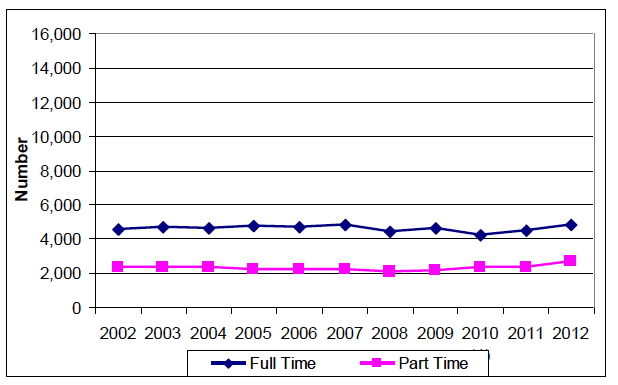
Chart 28: Regular Staff, June 2012
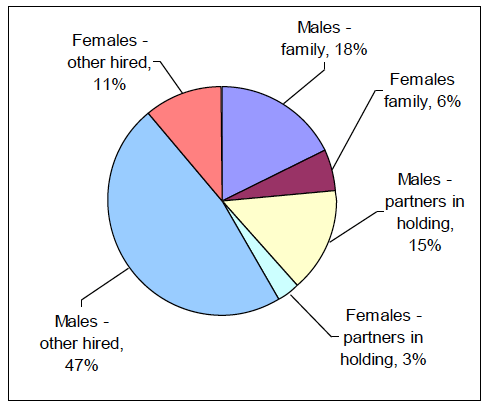
Chart 28 breaks down in greater detail the relative proportions of regular staff noted in Charts 26 and 27. On the 1st June 2012, there were 21,000 regular staff working on agricultural holdings.
Around a quarter (24 per cent) were members of occupiers' families and a further 18 per cent were business partners in the holding. The remaining staff were other hired staff (59 per cent), the majority of whom were males.
Chart 29: New Entrants, 2002 to 2012
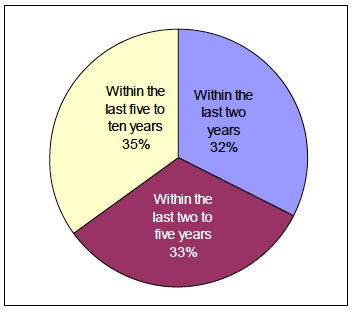
A new question was added to the survey in 2012 requesting information on new entrants to farming. This question will provide a greater understanding of the nature of farm succession within Scottish agriculture.
There were 1,530 respondents (about three per cent) who reported that they had become the head of a farm business within the last ten years. They were split fairly evenly between those becoming head within the last two years (32 per cent), within the last two to five years (33 per cent) and within the last five to ten years (35 per cent).
3.18 Tenancy Agreements (Table 9)
Information on agricultural tenancy agreements is collected on the June agricultural census for those holdings that rent land. The statistics below exclude croft holdings and holdings that rent land seasonally for less than 365 days.
This is the first time that tenancy agreement statistics have been included in this National Statistics publication. In the past the information has been released as "occasional updates" but following a methodology review last year this series will be produced on a regular basis going forward and included in this output. For further detail on the methodology of producing tenancy statistics please consult the detailed paper available on the tenancy section[3] of the website.
In 2012 there were estimated to be 6,670 holdings with tenancy agreements. The most common agreement was a 91 Act tenancy which accounted for 5,402 agreements (81 per cent of holdings with tenancies). This was followed by:
- Short Limited Duration Tenancy (SLDT) with 540 agreements (8.1 per cent of holdings);
- 91 Act Partnership with 512 agreements (7.7 per cent of holdings);
- Limited Duration Tenancy (LDT) with 321 agreements (4.8 per cent of holdings);
- Small Landholders Act (SLA) with 104 agreements (1.6 per cent of holdings).
Please note that a single holding can have more than one agreement type in place.
Chart 30: Number of holdings with Tenancy Agreements, 2005- 2012
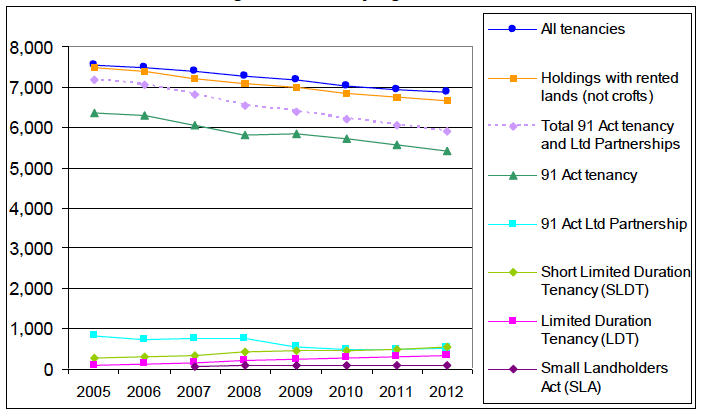
Notes:
1 - Holdings can have tenancies of different types, which is why the "All tenancies" total is slightly higher than the number of "Holdings with tenancy agreements"
2 - Crofts and seasonal rents of less than 365 days are excluded
Trends in agreements are presented in charts 30 and 31. In the last year there has been a decrease of 72 holdings with tenancy agreements (1.1 per cent) from 6,743 in 2011 to 6,670 in 2012. Over the longer term since 2005 there has been a decrease of 800 holdings (11 per cent) with tenancy agreements from 7,470 holdings in 2005 to 6,670 in 2012. In particular:
- There has been an overall reduction of 1,259 (18 per cent) holdings with either a 91 Act Tenancy or a 91 Act Limited Partnership Agreement, from 7,172 in 2005 to 5,913 in 2012.
- The number of holdings with Short Limited Duration Tenancies (SLDTs) has increased by 255, from 285 in 2005 to 540 in 2012.
- The number of holdings with Limited Duration Tenancies (LDTs) has increased by 222, from 99 in 2005 to 321 in 2012.
- The number of holdings with Small Landholder Act (SLAs) tenancies has remained fairly constant between 2008 and 2012, ranging between 91 and 104.
Chart 31 shows detail from chart 30 for those categories with fewer than 1,000 agreements.
Chart 31: Number of holdings with Tenancy Agreements, 2005- 2012
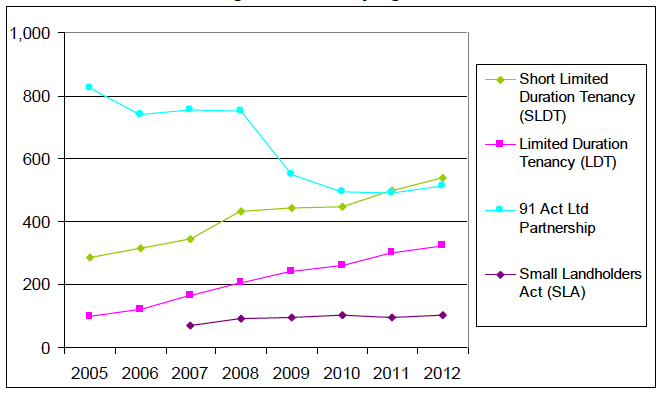
Notes:
1 - Holdings can have tenancies of different types, which is why the "All tenancies" total is slightly higher than the number of "Holdings with tenancy agreements"
2 - Crofts and seasonal rents of less than 365 days are excluded
Contact
Email: agric.stats@gov.scot
There is a problem
Thanks for your feedback